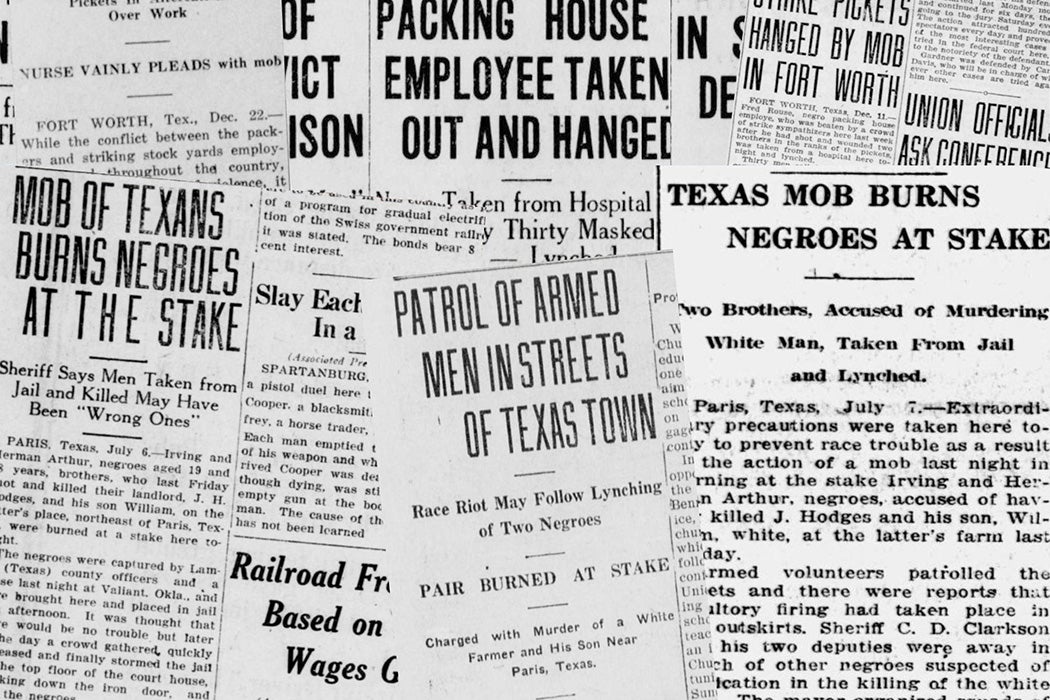The victims of lynching were overwhelmingly Black men. Black women were also lynched, but this history has received scant attention until recently. As an example, scholar Haley Brown found eleven confirmed cases of Black women lynched in the state of Texas, compared to hundreds of men lynched in that state.
These women were, writes Brown, lynched for something a male acquaintance, spouse, partner, or family member was accused of. Each was lynched with others: Lizzie Jackson was lynched with her husband and three others in 1885; Sallie Molena was killed by a mob alongside her husband and young daughter in 1890; Fanny Phillips was murdered along with her husband, four sons, a granddaughter, and two hired hands in 1895 when their home was firebombed and riddled with bullets.
Brown details the case of Mary Jackson, who was lynched in Harrison County, Texas, in February 1912. Jackson was around forty years old and was hung alongside her older neighbor, George Sanders.
“The lynching of Jackson and Sanders demonstrates the ways a lynch mob supported an eye-for-an-eye mentality without regard for the gender of the person who paid for the crime, so long as the person was Black,” writes Brown. “Although they surely would have preferred to lynch [Tennie] Sneed himself, the mob seemed content to lynch any Black person related to the crime.”
Tennie Sneed had shot and killed a white man, Paul Strange, in what was plainly a case of self-defense. But Harrison County had a “long history of racial violence”—five Black men were lynched together in 1901; four Black men were lynched in two separate instances in 1909; and just three months before Sneed’s crime, a mob hung Will Ollie—so “many Black citizens left town due to fear of retaliation.” Sneed also fled. White vigilantes initially responded by attacking the members of Sneed’s family who they could find, whipping his brother-in-law, father-in-law, wife (four months pregnant), and mother-in-law.
After Sneed was arrested, a mob showed up at the Harrison Co. jail demanding he be released to them. But he wasn’t there. He had been sent to another county for his own protection. The mob, however, felt they had to kill somebody Black: substitution of Black surrogates was “common” when law enforcement shielded the intended victim. That night, the mob went after people only tangentially related to Sneed’s action. Jackson, who lived on Paul Strange’s property, had worked as his cook and housekeeper.
As Brown stresses, the lynching of women undermined one of the primary justifications for lynch law, the defense of “womanhood.” That was very much white womanhood, but, typically, mobs who lynched Black women did so away from the public eye. Jackson and Sanders were lynched at night by a small group of men.
It was legitimate for white women and children to watch the violent communal rituals of public lynchings, which could include castration, burning, and other tortures. But white women and children were generally not supposed to see Black women being lynched. Brown suggests “mobs knew in some manner that lynching women was more dishonorable than lynching men, but not wrong enough” to prevent them from doing so.
Local “public opinion sided with the lynch mob,” with the county newspaper, without evidence, calling Jackson and Sanders accessories to the Strange killing. No members of the lynch mob were punished for taking the law into their own hands—they never were. But, in an unusual instance of criticism of one of the pillars of the reign of terror that enforced white supremacy, the Dallas Morning News scolded Harrison County whites, saying the two victims were “probably innocent” and that lynching women (and children) “lowered the standard of citizenship.” Brown thinks it unlikely the News would have been critical had Sanders been lynched on his own.
Weekly Newsletter
After two trials ended in juries unable to come to a verdict, Tennie Sneed was convicted of manslaughter in 1914. The jury forthrightly stated they thought “the defendant would be killed if acquitted.” He served three years in prison and lived until 1972.
Texas was not, of course, unique when it came to lynching Black women. Perhaps the most infamous incidence was that of Mary Turner in 1918. Eight months pregnant, Turner was murdered in a savage orgy of a violence by white citizens of Georgia who were enraged that she had spoken out against the lynching of her husband a day earlier.







